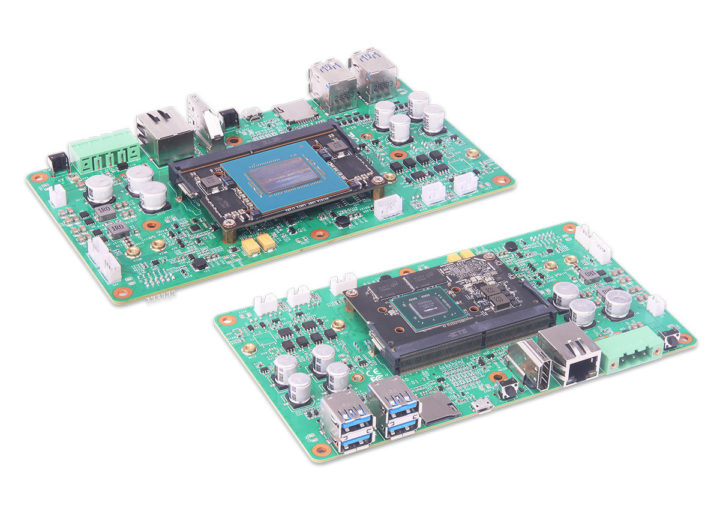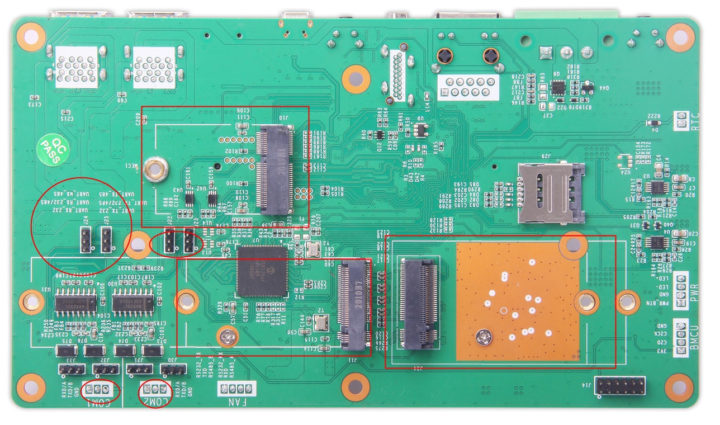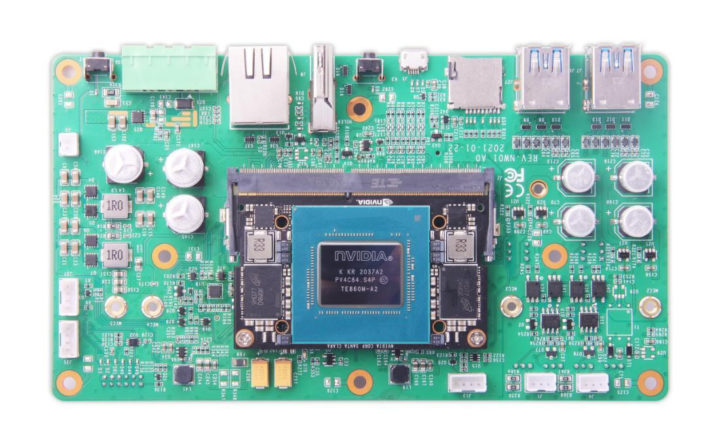 Geniatech NVJ100AI/NVJ100AIX is a carrier board fitted with either Jetson Nano or Jetson Xavier NX SoM with good expansion capabilities thanks to three M.2 sockets and ten RS232 and/or RS485 interfaces, plus the usual Gigabit Ethernet, USB ports, HDMI video interface, etc…
Geniatech NVJ100AI/NVJ100AIX is a carrier board fitted with either Jetson Nano or Jetson Xavier NX SoM with good expansion capabilities thanks to three M.2 sockets and ten RS232 and/or RS485 interfaces, plus the usual Gigabit Ethernet, USB ports, HDMI video interface, etc…
Geniatech NVJ100AI/NVJ100AIX specifications:
- SoM
- Geniatech NVJ100AI – NVIDIA Jetson Nano with
- CPU – Quad-core Arm Cortex A57 MPCore processor @ up to 1.43 GHz
- GPU – Maxwell GPU, 128 CUDA core up to 512 GFLOPS (FP16)
- System Memory – 4GB LPDDR4
- Storage – 16GB eMMC flash
- AI Performance – Up to 472 GFLOPS in 10 Watts mode
- Geniatech NVJ100AIX – NVIDIA Jetson Xavier NX
- CPU – Hexa-core NVIDIA Carmel ARMv8.2 64-bit CPU with 6MB L2 + 4MB L3 cache
- GPU – 384-core NVIDIA Volta GPU with 48 Tensor Cores
- Dedicated AI accelerators – 2x NVDLA Engines, 7-Way VLIW Vision Processor
- System Memory – 8GB LPDDR4
- Storage – 16GB eMMC flash
- AI Performance – Up to 21 TOPS (INT8) in 15 Watts mode
- Check our Jetson Nano/TX2/Xavier NX/AGX comparison for more details about the modules
- Geniatech NVJ100AI – NVIDIA Jetson Nano with
- Storage – MicroSD card slot, M.2 NVMe SSD via M.2 socket
- Video Output – HDMI 2.0 up to 3840×2160 @ 60Hz
- Networking
- Gigabit Ethernet RJ45 port
- Optional WiFi & Bluetooth support via M.2 socket
- Optional 4G LTE or 5G via M.2 socket plus SIM card slot
- USB – 4x USB 3.0 Type-A ports, 1x micro USB 2.0 port
- Serial – 4x RS232 headers, 4x RS232/RS485 headers, 2x RS485 headers
- Expansion
- M.2 KEY-E socket for WIFI/BT
- M.2 KEY-M socket for NVMe SSD
- M.2 Key-B socket
- “Automation” header
- Misc – Reset & Recovery buttons, header for a power button and LED, fan header, RTC via MCU + battery
- Power Supply – 12V/1.5A DC via terminal block
- Dimensions – 170 x 97mm
- Weight – 150 grams
- Certifications – CE, FCC

On the software side of thing, it’s the usual story for Jetson hardware with support for the Ubuntu-based NVIDIA JetPack, CUDA-X software stack with NVIDIA DeepStream and the Transfer Learning Toolkit for intelligent video analytics, NVIDIA Clara for healthcare imaging, genomics, and patient monitoring, as well as NVIDIA Isaac for robotics.
While the board joins other Jetson Xavier NX/Nano carrier boards, the company has taken a different approach, as you’ll notice the complete lack of MIPI CSI camera interfaces, and the 10 serial ports and three M.2 sockets make it a Jetson Nano carrier board that’s a bit unusual. It’s possible to connect up to four cameras through the USB 3.0 ports.
Geniatech says the board is suitable for entry-level Network video recorders (NVR), home robots, and intelligent gateways with full analytics capabilities. The Geniatech NVJ100AI/NVJ100AIX boards are available now, but contrary to the just-launched Geniatech XPI-iMX8MM SBC, are not sold through Geniatech’s online store, and you’d have to contact them through the product page for a volume quote.

Jean-Luc started CNX Software in 2010 as a part-time endeavor, before quitting his job as a software engineering manager, and starting to write daily news, and reviews full time later in 2011.
Support CNX Software! Donate via cryptocurrencies, become a Patron on Patreon, or purchase goods on Amazon or Aliexpress






Looks pricey.
Are they using a PCIe switch? How do the three M.2 sockets work? nVidia’s Jetson Modules page says the Jetson nano has 1 x4 (PCIe Gen2) and the Xavier NX has 1×1 (PCIe Gen3, Root Port) + 1×4 (PCIe Gen4, Root Port & Endpoint).
That would most likely be the Microchip chip on the bottom of the board. So the answer to your question is yes, they’re splitting the x4 interface into four x1 interfaces.